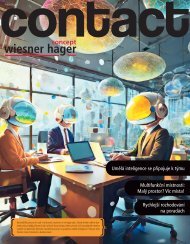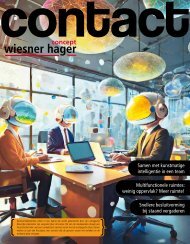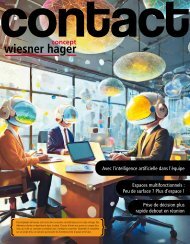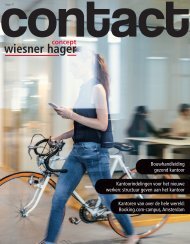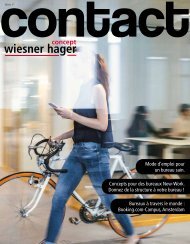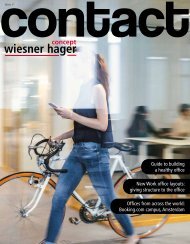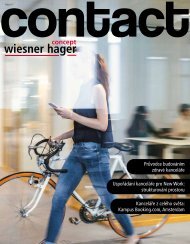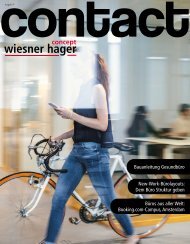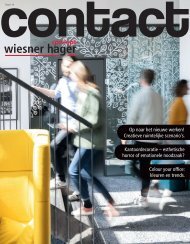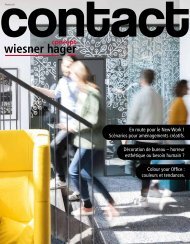contact_office_magazine_#38_EN
Welcome to the latest issue of contact – your trusty companion through the ever-evolving world of work. In this issue, we’re focusing on the topic of artificial intelligence and its influence on office working. Is AI nothing more than a nice assistant, or will it soon become a colleague?
Welcome to the latest issue of contact – your trusty companion through the ever-evolving world of work. In this issue, we’re focusing on the topic of artificial intelligence and its influence on office working. Is AI nothing more than a nice assistant, or will it soon become a colleague?
Create successful ePaper yourself
Turn your PDF publications into a flip-book with our unique Google optimized e-Paper software.
Office Concepts<br />
The role of the <strong>office</strong> is fundamentally changing.<br />
While spaces for focused work are becoming smaller<br />
with people increasingly working from home or<br />
remotely, the need for communication zones is<br />
growing. The <strong>office</strong> is becoming more of a space for<br />
collaboration, creative communication, and training<br />
and education. Often, the existing space cannot keep<br />
pace with these new scenarios. The solution lies in<br />
multifunctional rooms, which require a great deal of<br />
planning consideration to work effectively.<br />
One space, many use cases.<br />
Obviously, companies can’t provide a separate<br />
room for every single communicative situation. But<br />
certain scenarios can be effectively combined in<br />
multifunctional rooms, particularly all the various<br />
kinds of training sessions: seminars, courses, lectures,<br />
presentations and workshops, etc. To facilitate this<br />
multi-use concept, the room needs appropriately<br />
flexible space, furniture and media concepts.<br />
Provided there is sufficient<br />
floorspace, a combined<br />
room concept<br />
increases the<br />
options available<br />
considerably.<br />
Two or three<br />
smaller multifunctional<br />
rooms<br />
can be combined to<br />
form one large event space by incorporating flexible,<br />
soundproof room division systems. This further<br />
expands the number of ways the room can be used<br />
– for example to include meetings, conferences and<br />
banquets.<br />
One of the most crucial factors in an effective multifunctional<br />
room is the acoustics. Textile flooring<br />
combined with acoustic ceiling panels are often the<br />
most effective way of making the space acoustically<br />
comfortable.<br />
Good light planning is also vital. Due to the changing<br />
use cases and configurations, the room should<br />
not contain single-spot illumination, but rather<br />
enjoy even lighting across the entire area.<br />
Mobility is key.<br />
The furnishings chosen should be as mobile as<br />
possible so that the room can be rearranged quickly<br />
without significant effort. And don’t forget that the<br />
furniture will need to be stored compactly either in<br />
the same room or a separate area.<br />
Stacking tables or pivoting folding tables on rollers<br />
are the best choice here. Any that aren’t needed can<br />
be effortlessly rolled from A to B and stacked on<br />
top of one another. In terms of chairs, criteria such<br />
as comfort, fast and simple setup, and a stackable<br />
design should be top priorities. Lecterns can be<br />
fashioned by arranging different pieces of furniture<br />
– from a traditional stand to small standing desks or<br />
mobile trolleys that can also hold parts of the media<br />
equipment and cabling. Sideboards can be used not<br />
only as storage for media equipment, but also as a<br />
place to set down any catering offerings.<br />
Media concept requirements have become considerably<br />
more sophisticated in recent years. Depending<br />
on the size of the room, projectors are increasingly<br />
being replaced by large screens. Mobile digital<br />
whiteboards are also becoming more commonplace<br />
in multifunctional rooms, as is video conferencing<br />
equipment to enable remote participants to join in<br />
seamlessly with hybrid events. But despite all this<br />
digitalisation, analogue media is still needed. Flipcharts,<br />
pinboards and whiteboards are still highly<br />
effective tools, especially when it comes to capturing<br />
information quickly and easily, or gathering creative<br />
ideas from a group. With the increasing use of digital<br />
media and devices, requirements are also rising in<br />
terms of the room’s electricity, network and media<br />
connections. Electricity cabling in particular requires<br />
thorough planning. The better the cabling is integrated<br />
into the furniture, the cleaner the cable management.<br />
However, overcomplicated connections can<br />
make it more difficult to switch between furniture<br />
setups. Cleverly positioned ports – ideally in floor<br />
boxes – combined with cable boxes integrated into<br />
the desks and tables, make plug-and-play a breeze.<br />
Wi-Fi technologies are, obviously, increasingly<br />
playing a leading role in the digitalisation of communication<br />
spaces. This particularly concerns wireless<br />
connections to the network and media equipment.<br />
When it comes to visualisation and presentation<br />
via wireless screensharing, there are also a range of<br />
sophisticated solutions that are well-supported by<br />
modern devices (smartphones, tablets, laptops) and<br />
screens.<br />
Zone planning in multifunctional rooms.<br />
A sophisticated zone and space plan is needed to<br />
cover all of the various scenarios a multifunctional<br />
room will play host to. The aim is to avoid wasting<br />
space and creating bottlenecks. Multifunctional<br />
rooms should be planned as communication zones<br />
whose size and layout are flexible and can support<br />
various forms of communication with the help of<br />
a mobile furnishing concept. You will need to plan<br />
the following areas: action zone for hosting and<br />
presentation duties, a participant area, areas between<br />
furniture for people to walk along, areas for storing<br />
furniture and equipment, and a breakout area nearby<br />
but ideally in a separate space from the actual communication<br />
room.<br />
WORKSHOP CONFER<strong>EN</strong>CE EDUCATION TRAINING<br />
CONCLUSION:<br />
The only way to use space<br />
efficiently is to plan intelligent and<br />
holistic zone and design concepts.<br />
These ensure the necessary communication<br />
quality and establish a<br />
positive meeting culture.<br />
8 <strong>contact</strong><br />
<strong>contact</strong> 9




